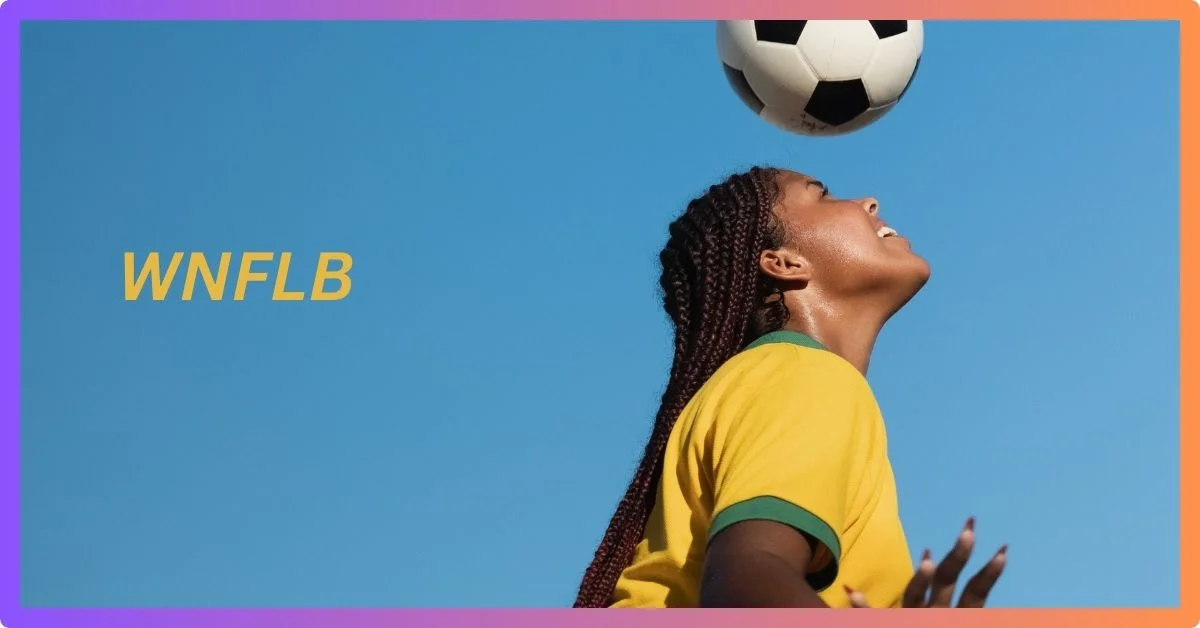Women’s participation in sports has evolved significantly over the past few decades. Despite remarkable strides in many sports, football (soccer in some regions) remains a challenging field for gender equality, with female athletes often facing barriers to entry, lower levels of funding, less media coverage, and fewer opportunities to compete at a professional level. The Women’s National Football League (WNFLB) stands as a beacon of change, offering a revolutionary approach to advocacy, empowerment, and gender equality in the world of professional football. This article explores the origins, evolution, impact, and challenges of the WNFLB, shedding light on the critical role it plays in creating opportunities for women to lead, innovate, and thrive in the football arena.
What is WNFLB?
The WNFLB represents a bold and transformative step towards gender equality in football, with the mission to bridge the gender gap in a sport that has traditionally been dominated by men. At its core, WNFLB aims to:
- Promote Gender Equality: Empower women by providing them with equal opportunities to compete and excel at the professional level, fostering an environment where talent is celebrated, irrespective of gender.
- Provide Access to Quality Education: Ensure that female athletes are not just athletes, but are also supported in their academic and professional pursuits outside of football.
- Ensure Fair Labor Practices: Advocate for better pay, working conditions, and career longevity for women in the sport.
- Empower Women to Lead and Innovate: Create pathways for women to assume leadership roles both on and off the field.
- Build Networks that Uplift Communities: Establish a sustainable, supportive network for female athletes, fans, and organizations to thrive together.
The WNFLB has become an essential force in promoting female participation in football by providing a platform for women to compete, inspire, and break barriers, but it also faces significant challenges as it continues to pave the way forward.
The Evolution of Women’s Football and the Birth of WNFLB
The journey of women’s football has been long and arduous, filled with both progress and setbacks. Women’s football leagues have existed in various forms since the early 20th century, though they were often ignored or outright suppressed. The modern WNFLB is the result of decades of advocacy, growth, and dedication to leveling the playing field.
The Early Days of Women’s Football
The roots of women’s football date back to the early 1900s, when the first official women’s football team was established in England in 1894. However, the sport struggled for recognition due to societal attitudes about women’s involvement in physical and competitive activities. Football was seen as a male-dominated sport, and women who pursued it were often met with resistance, ridicule, and even bans.
In the United States, the path was similarly rocky. Women’s informal football teams began appearing in the 1970s, often organized by passionate athletes in local communities. These were grassroots efforts, often played on community fields with little to no professional structure. The lack of institutional support and visibility was a major barrier to the growth of women’s football during this time.
The 1990s: The Rise of Women’s Professional Football Leagues
A significant turning point occurred in the late 1990s with the creation of the Women’s Professional Football League (WPFL), the first attempt to establish a national professional league for women in the U.S. The WPFL, which launched in 1999, provided an official platform for female athletes to compete in professional football, although it struggled with financial sustainability and was short-lived.
Despite the early failure of the WPFL, it laid the groundwork for future leagues. In the early 2000s, a number of other women’s football leagues emerged, such as the National Women’s Football Association (NWFA), which began gaining traction and drawing attention to the potential for professional women’s football. However, these leagues faced challenges similar to those of their predecessors—issues with funding, media coverage, and competition with well-established men’s leagues kept them from reaching their full potential.
The Growth of Women’s Sports and the Birth of WNFLB
While the success of women’s football leagues in the 1990s and 2000s was limited, the increased attention to women’s sports as a whole led to greater opportunities for women in football. The success of the U.S. Women’s National Soccer Team and the rising visibility of female athletes across various sports sparked a shift in the landscape. More people started to recognize the need for structured professional football leagues for women.
It was during this period of growth and greater visibility that the Women’s National Football League (WNFLB) was born. With its primary goal of creating a sustainable community for female athletes, the WNFLB has worked to break down barriers, empower women, and bring more attention to women’s football.
Core Objectives and Values of WNFLB
The WNFLB’s mission is not just about providing women with a chance to play football; it’s about empowering them in every facet of their lives. Through its core objectives, the league works to bring about systemic changes to the way women are perceived and treated in the sports world.
Promoting Gender Equality in Football
The WNFLB advocates for equal opportunities and resources for women in football, striving to ensure that female athletes have the same access to professional careers, sponsorships, and media coverage as their male counterparts. Gender equality in football is an ongoing battle, and the WNFLB seeks to change the narrative surrounding women’s involvement in the sport by demonstrating that women can excel at the highest levels.
Providing Access to Education
The league goes beyond just football by providing educational support to its players. The WNFLB understands that a career in professional football is often short-lived, and as such, the league encourages its athletes to pursue education and personal development. Many players are offered opportunities to continue their studies while competing, preparing them for careers beyond the field. This focus on holistic development ensures that players are not solely defined by their athleticism but are equipped for success in all areas of life.
Advocating for Fair Labor Practices
Fair pay, working conditions, and career longevity are crucial for female athletes, and the WNFLB is dedicated to ensuring that these principles are upheld. By establishing fair compensation for players and providing career development opportunities, the WNFLB helps women maintain long-term careers in football, free from exploitation. The league is also working toward securing benefits such as healthcare, retirement plans, and mental health support for its athletes.
Empowering Women to Lead and Innovate
Another major goal of the WNFLB is to create opportunities for women to assume leadership roles both on and off the field. Whether through coaching, management, or administration, the WNFLB strives to ensure that women have the chance to make decisions, drive change, and shape the future of football. By placing women in positions of leadership, the league aims to change the gender dynamics of football at all levels.
Building Community Networks
One of the most unique aspects of it is its focus on building a supportive, sustainable community for female athletes. By engaging with local communities and fostering connections between players, coaches, and fans, the league has become a powerful force for change. It is not just about playing football; it’s about creating a network of support that helps elevate the sport and its participants. The WNFLB works closely with schools, local sports organizations, and women’s advocacy groups to ensure that the impact of its work extends far beyond the field.
The Challenges Facing the WNFLB
While the WNFLB has made significant progress, there are still numerous challenges to overcome. The journey to gender equality in football is far from complete, and the league faces obstacles that hinder its ability to thrive.
Financial Constraints
One of the most pressing challenges for the WNFLB is securing stable financial support. Like many women’s sports leagues, it has struggled with attracting investors and sponsors who are willing to invest in a product that has not yet garnered the same commercial appeal as men’s football. With lower attendance at games, fewer sponsorship deals, and less media coverage, the WNFLB faces significant financial hurdles as it works to establish itself as a sustainable and profitable league.
Limited Media Coverage
Despite the growing popularity of women’s sports, media coverage remains limited, and the WNFLB is no exception. While men’s football leagues dominate television broadcasts and news coverage, women’s leagues often struggle to attract the same level of attention. This lack of media visibility makes it difficult for the WNFLB to grow its fanbase, secure sponsors, and attract talented players who may see little chance of achieving national recognition.
Competition with Established Leagues
Another challenge the WNFLB faces is competition with established men’s leagues, particularly in football, where the NFL dominates the global sporting landscape. This creates a situation where the women’s game is often relegated to the sidelines, overshadowed by the much larger infrastructure, fanbase, and financial backing of male-dominated leagues.
Looking Ahead: The Future of WNFLB
Despite these challenges, the future of the WNFLB looks promising. The league’s commitment to empowerment, inclusivity, and equality is already having a profound impact on the lives of women athletes and the communities they represent. With continued advocacy for fair pay, greater media exposure, and more opportunities for sponsorship, the WNFLB is poised to play a critical role in changing the narrative around women’s football.
As interest in women’s sports continues to grow, the WNFLB will undoubtedly lead the charge in breaking down barriers and ensuring that women have an equal place in the world of professional football. By continuing to champion gender equality, providing access to education, advocating for fair labor practices, and creating pathways for leadership and innovation, the WNFLB is set to be a transformative force in the world of sports.
Conclusion
The WNFLB represents the future of women’s football, where the barriers of inequality are torn down and replaced with opportunities for empowerment, leadership, and sustainable growth. While challenges remain, the league’s commitment to promoting gender equality, providing access to education, ensuring fair labor practices, and building supportive networks for female athletes is making an indelible mark on the sports world. As we look to the future, the WNFLB stands as a symbol of hope and change for women in football and beyond.
FAQs
- What is the primary goal of the WNFLB? The primary goal of the WNFLB is to promote gender equality, provide opportunities for women in football, and create a sustainable and empowering environment for female athletes.
- How did the WNFLB come about? The WNFLB was created in response to the lack of professional opportunities for women in football. It builds on decades of progress in women’s sports and aims to fill the gap left by previous leagues.
- What challenges does the WNFLB face? The WNFLB faces financial constraints, limited media coverage, and competition with established men’s leagues, which make it difficult to achieve widespread recognition and sustainability.
- How does the WNFLB empower its players? The WNFLB empowers its players by providing access to education, advocating for fair labor practices, and creating opportunities for women to take on leadership roles within the sport.
- What impact does the WNFLB have on women’s football? The WNFLB plays a crucial role in raising the profile of women’s football, advocating for gender equality, and providing a platform for female athletes to compete at the professional level.
- What is the future of the WNFLB? The future of the WNFLB looks promising, with growing support for women’s sports and an increasing commitment to providing equal opportunities, better resources, and fair compensation for women in football.









